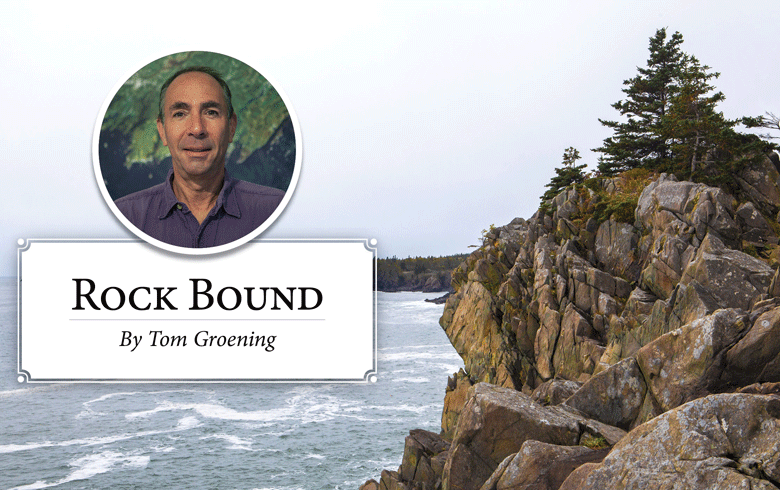I was walking recently along Belfast’s Harbor Walk, a paved trail that follows the shore along a large lawn area where a shuttered poultry plant once stood, past a boat dealer and marina, across Main Street and, amazingly, through the Front Street Shipyard, offering views of yachts, ocean-going fishing vessels, and whale watch boats.
And those views are so intimate and close that I often touch my hand to a propellor or tap a hull with my knuckle. The plastic wrap around the 440-metric ton lift rustles in the wind, and I have to guide the dog away from the edge, because given half the chance, she’d consider a leap into the water.
The final stretch, as I walk it from the southwest to the northeast, takes me across the former Route 1 bridge. Or, a walker or biker can continue northwesterly for a couple of miles along the Rail Trail, as it’s known, following a former railroad bed.
So parks can approach being art, right? Visit and see if you agree.
It’s a silly question, but I pondered it nonetheless—is this a park? The term “greenbelt” is often used to describe this sort of public infrastructure. You’ve heard of the repurposing of elevated train systems in New York, for example, turning them into walkways with benches and planters.
A friend in Belfast who has served as mayor and city councilor launched what I thought was a radically subversive endeavor decades ago, creating a small volunteer group called GreenStreets! While more conservative city government officials probably thought it was an innocuous effort, like the garden club hanging flower baskets from light poles, in reality, trees that will grow tall and live for 40 years were being established along the main thoroughfares.
In once sense, it wasn’t radical—elms once lined many Maine downtown streets, it’s just that disease killed them. Yes, the city is on the hook for maintenance, but trees make a downtown cooler in summer and more inviting to visitors.
An aside—another volunteer group once cleared a little-used parking lot of trash, abandoned shopping carts, and branches, and a then-city councilor chastised them, saying it meant the city would now have to care for the lot.
We had a friend who came to Maine to attend college and her boyfriend at the time refused to take her to Acadia, saying it wasn’t real Maine wilderness, and instead preferred the wilds of—ironically enough—paper company land up north. Acadia does have a genteel quality, with its carriage trails, arched bridges, paved roads, and heavily walked trails. But wander off those trails and the rocks, streams, and trees are real.
When the Land for Maine’s Future fund was first established, purchases tended to lean toward tens of thousands of inaccessible acres in the north, and yes, stopping clearcutting and spraying insecticides on that land is a win. But soon, LMF’s conservation focused on places people could actually visit.
In the early 2000s, I reported on Camden’s efforts to spruce up the park adjacent to the town’s library and the amphitheater that was its back yard.
I learned that both were a gift in 1931 by Mary Louise Curtis Bok, from a wealthy magazine publishing family, and that the amphitheater was designed by Fletcher Steele and is considered the first public Modernist landscape. The adjacent Harbor Park was designed by the renowned Olmsted firm under the direction of Frederick Law Olmsted Jr.
In any season, those landscapes, though relatively small, are visited by locals and tourists. So parks can approach being art, right? Visit and see if you agree.
I recently received a press release about the Outdoors for All Act, co-sponsored by Sen. Susan Collins, which would “expand outdoor recreational opportunities in urban and low-income communities” and “allow for equitable access to the benefits of local parks, from job creation, to shade and tree cover, to clean air…”
The Europeans who built our towns brought with them another progressive idea—establishing a village green. In some towns, the green was a place farmers could graze their livestock. Talk about collectivism.
In Belfast, the green is actually a public square on which the First Church was built along with the city’s public high school. The city’s founders knew these public institutions were critical to growing a successful community.
How we understand the variety of public spaces is important, but more important is to invest in and protect them.
Tom Groening is editor of The Working Waterfront. He may be reached at tgroening@islandinstitute.org.





